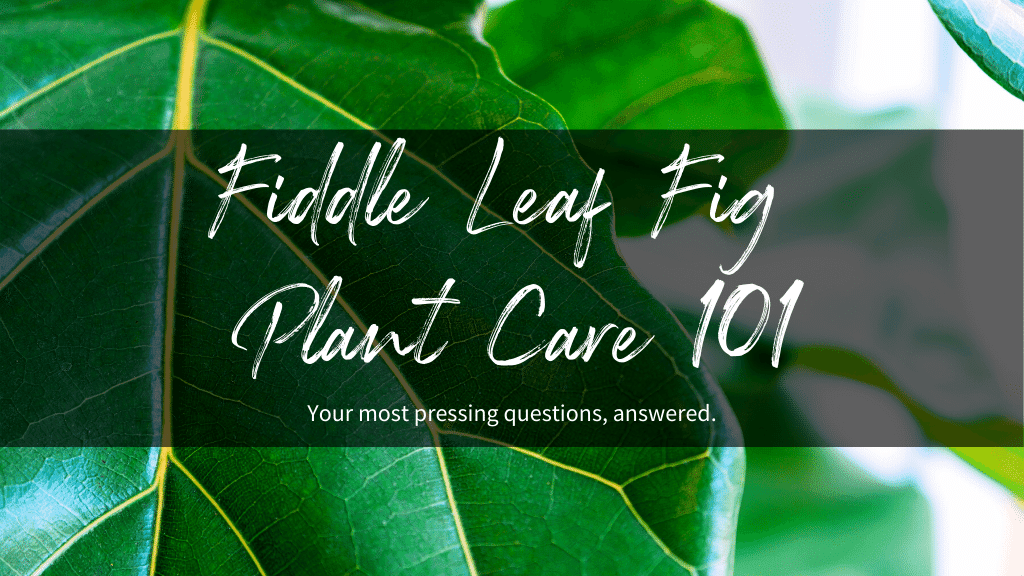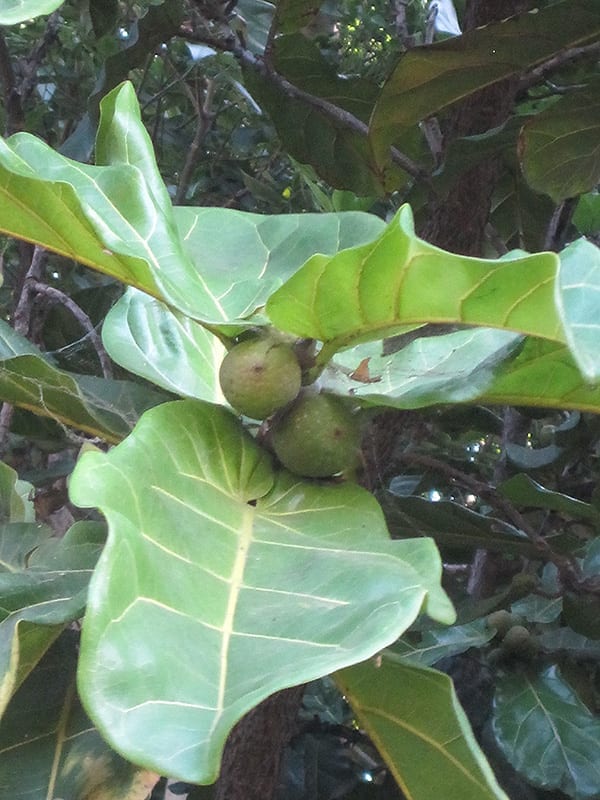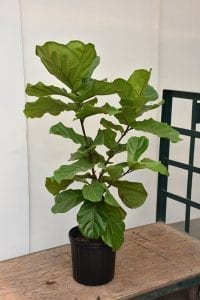Es la planta que aparece en las listas de los diseñadores de interioresy adorna las páginas de todas las revistas o fotos de Instagram. Tiene poder de permanencia en el diseño y simplemente se niega a hojear leaf (¿entiendes?). A veces se puede ver su nombre acortado en artículos modernos a FLF o "Fiddle". ¿Qué planta es? Es la higuera de hoja de violín.
La higuera de hoja de violín es un excelente ejemplar y una planta de suelo.Las hojas son inusualmente grandes y tienen una bonita forma de violín. (Por lo tanto, el nombre de la planta.) El color verde brillante de las hojas es un acento agradable para una variedad de estilos de decoración..
Dado que intentamos disfrutar de esta llamativa planta en un clima radicalmente distinto, algunos podrían haberla estereotipado como "quisquillosa". Pero, cuando se cultiva en interiores, en realidad es bastante fácil de cultivar. Si nos tomamos el tiempo de imaginarnos en su hábitat nativo, el cuidado se vuelve mucho más sencillo. Así que, sí... amantes de las plantas de interior del Medio Oeste, ¡ustedes también pueden cultivar fácilmente estas bellezas!
Ten en cuenta que estas plantas son caseras. Eso significa que no les gusta que las cambien de sitio cada semana o cada mes. Cuando compres tu planta y la lleves a casa por primera vez, recuerda que los higos de hoja de violín pueden ser sensibles a los cambios de condiciones como la luz o la temperatura. Y es probable que las condiciones de tu casa sean diferentes a las que tuvo la planta durante su estancia en el invernadero. Pero ten en cuenta estos consejos para el cuidado de las plantas de interior y tendrás la Higuera más feliz de la ciudad.
¿De dónde procede la planta de higo de hoja de violín?
Incluso cuando crece en el interior, la higuera de hoja de violín (Ficus lyrata) sobrevive en condiciones muy diferentes a las de su entorno nativo. Las higueras de hoja de violín son originarias de la selva tropical de África Occidental. Estas plantas crecen bajo el dosel del bosque. Por tanto, su entorno nativo es luminoso, pero no soleado, y el aire es cálido y húmedo. Las condiciones tropicales ofrecen a las Fiddle Leaf Figs lluvias regulares. Si puede imitar estas condiciones, es probable que tenga éxito con esta planta.
Pertenecen a la familia hortícola de las Moraceae y están estrechamente relacionados con otros ficus.Entre sus especies afines se encuentran el baniano (Ficus benghalensis) y la la planta del caucho (Ficus elastica)Los ficus detienen su crecimiento en los periodos más oscuros y fríos del año (de noviembre a febrero). Así, su mayor periodo de crecimiento se produce a principios de la primavera (de marzo a mayo).
¿Qué tamaño tiene un Fiddle Leaf Fig?
Cuando se cultiva en el interior y en nuestro clima, una planta de interior de higo de hoja de violín puede alcanzar 6 pies de altura o más. Los higos de hoja de violín más jóvenes pueden vivir temporalmente en estanterías mientras son pequeños. A medida que crecen, se suelen ver como plantas de suelo. Muchas condiciones afectan a la altura final, la extensión y el rendimiento de estas plantas de interior. Algunos de esos factores son:
- el tamaño de la maceta en la que crece
- la cantidad de luz que recibe
- la frecuencia de riego
- el régimen de poda y el calendario de trasplante.
¿La higuera de hoja de violín da frutos?
Fuera de su hábitat nativo, una higuera de hoja de violín rara vez florece o fructifica. Sin embargo, hemos incluido una foto del aspecto de la fruta (derecha).
La mayoría de los propietarios disfrutan de estas plantas de interior por su follaje y estatura, más que por su capacidad de dar frutos.
¿Cuánta agua necesita mi higuera de hoja de violín? ¿Con qué frecuencia debo regarla?
Es importante hablar del riego,, el drenaje y la humedad en el mismo pensamiento. Como plantas tropicales, aprecian un entorno húmedo. Si las condiciones son demasiado secas, sus hojas se caerán. Esto significa que siempre hay que evitar colocarlas directamente frente a una salida de aire.
Aunque la mayoría de los higos de hoja de violín son bastante resistentes a las condiciones de interior y se adaptan a ellas, puedes ayudar a dar un empujón a tu planta aumentando los niveles de humedad. Para ello, llene un platillo 1-2 veces más grande que la maceta con guijarros o piedras pequeñas. Coloca la maceta de la planta encima de las piedras, manteniendo el agua suficiente para cubrir el fondo del platillo. Pero asegúrate de que hay suficientes piedras para que la maceta no esté sentada directamente en el agua. (Debemos insistir: no llenes el agua hasta la parte superior de las piedras. La maceta no debe tocar el agua del platillo). O bien, coloque la bandeja de humedad (piedras y agua) cerca de la maceta en lugar de colocar la maceta encima de ella. El agua se evaporará y aumentará la humedad. Otra opción para atrapar la humedad es colocar tu Higuera entre otras plantas en maceta.
No te engañes pensando que la tierra húmeda y la humedad son lo mismo. No lo son. Su Fiddle Leaf Fig estará mejor en condiciones de humedad uniforme y constante, pero no tolerará la tierra empapada o el agua estancada. Deje que la pulgada superior de la tierra se seque entre los riegos. (Pero no deje que se seque por completo para que se forme una costra).
Mike Davison, principal comprador de invernaderos en Platt Hill Nursery, recomienda: "Hay que dar de beber a la planta. Eso significa que hay que regar la planta hasta que la maceta esté lo más pesada posible. Luego, cuenta cuántos días pasan hasta que esté bastante ligera para levantarla, pero no marchita. Esa es la frecuencia con la que regarás esa planta en concreto hasta que cambie el entorno. Vuelve a contar los días de riego cuando cambies el entorno de tu casa. Es decir, cuando empiece a funcionar la calefacción o el aire acondicionado. La mayoría de los problemas que escucho de mis clientes es por un riego inadecuado".
Tenga en cuenta que su programa de riego particular puede ser diferente según su ubicación en la habitación, el tamaño de la maceta o el tamaño de la planta.
¿Cuáles son los requisitos de luz y temperatura de la higuera?
La planta de higo de hoja de violín debe tener un entorno muy iluminado. Sus necesidades de luz suelen ser mayores que las que puede proporcionar la iluminación artificial de interior. Será más feliz cuando reciba luz solar directa o indirecta. (Una ventana orientada al este que reciba un sol suave por la mañana sería lo ideal). Si su Higuera está frente a ventanas grandes o de un solo cristal, la planta puede quemarse fácilmente con el sol. Las hojas quemadas por el sol o chamuscadas pueden variar de color, dependiendo de la exposición que hayan tenido. El color de las hojas puede ser blanco, amarillo, marrón claro o marrón medio. Las hojas pueden terminar sintiéndose crujientes y pueden tener un anillo amarillo alrededor del borde de la mancha marrón.
También es una buena práctica girar la planta un cuarto de vuelta con cada riego. Esto ayuda a garantizar una exposición uniforme a la luz solar, especialmente si la planta está contra una pared o en una esquina de la habitación.
¿Tengo que pensar en una tierra especial para macetas o en fertilizantes?
Si vas a plantar o trasplantar, lo mejor es una mezcla sin suelo que drene bien. Hay grandes opciones de Miracle Grow o Espoma. Te recomendamos que te pongas en contacto con los expertos de Platt Hill Nursery si tienes alguna duda.
Una vez plantado, un fertilizante multiuso (20-20-20) funcionará bien. Recomendamos aplicar el fertilizante sólo durante la temporada de crecimiento. (marzo-octubre)
¿Qué tipo de maceta es mejor para una higuera de hoja de violín?
Lo mejor es una maceta con buen drenaje. Algunos clientes han tenido éxito con una maceta de terracota o cerámica.Estos materiales son más porosos y pueden ofrecer una humedad de la tierra más uniforme en toda la maceta, por lo que son ideales para los propietarios novatos de Fiddle.
Pero, aparte del material, es importante pensar en el tamaño de la maceta. El objetivo es proporcionar un recipiente que sólo sea aproximadamente 1-2 pulgadas más grande que su maceta actual. Si trae la planta a casa durante el otoño o el invierno, puede considerar mantenerla en su contenedor de vivero (a veces llamado "lata") hasta la primavera. Una higuera de hoja de violín recién comprada va a experimentar muchos cambios cuando la traiga a casa. Por lo tanto, posponer el trasplante puede evitar un factor de cambio adicional. Si una lata de vivero no encaja con su decoración, considere colocar la lata de vivero dentro de su maceta decorativa. Sólo asegúrate de apuntalar la maceta del vivero dentro de la decorativa para evitar que se balancee o se caiga, ya que eso puede dañar las hojas. Es bastante fácil hacer esto con piedras pequeñas, pero los rellenos de jarrones decorativos pueden ser más ligeros y pueden añadir estilo.
¿Qué otro tipo de mantenimiento se recomienda? ¿Debo podar mi planta?
Limpie las hojas con un paño húmedo de vez en cuando para eliminar el polvo. Para hacer esto con el menor daño o estrés posible en las hojas, acune suavemente la hoja en una mano. A continuación, pase el paño húmedo por la parte superior de la hoja con la otra mano. Esto proporcionará apoyo a la parte de la hoja conectada a la rama o al tronco, reduciendo al mismo tiempo la probabilidad de magullar la propia hoja. Solo limpie el polvo en la parte superior de la hoja, no en la inferior.
Aunque no es necesario, la poda de la mayoría de los ficus los ficus es mejor hacerla a finales del invierno, y la higuera de hoja de violín no es una excepción. La poda fomenta la ramificación, que proporciona una planta más completa con más hojas. Podar demasiado tarde en la temporada de crecimiento o durante el invierno puede eliminar las hojas que la planta necesita. Además, durante los meses más oscuros del invierno, ¡puede utilizar todo el poder de fotosíntesis que pueda! Por eso, los primeros días de febrero suelen ser el mejor momento para podar sin sacrificar el nuevo crecimiento que puede aparecer en marzo. La primavera también es un buen momento para considerar el trasplante..
Especificaciones de la planta de higo de hoja de violín
- Nombre botánico: FICUS LYRATA
- Familia hortícola:: Moraceae
- Origen: West Africa, Tropical Jungle
- Follaje: Hojas verdes muy grandes
- Altura: 6 pies
- Extensión: 4 pies
- Hábito: Erguido, como un árbol. Se puede podar como arbusto.
- Utilización:
- Como árbol - planta de interior de suelo
- Como mini planta de interior en el alféizar de la ventana
- Toxicidad: Posible irritación estomacal en animales domésticos o personas, si se ingiere
Platt Hill Nursery es el principal centro de jardinería y vivero de Chicago.




